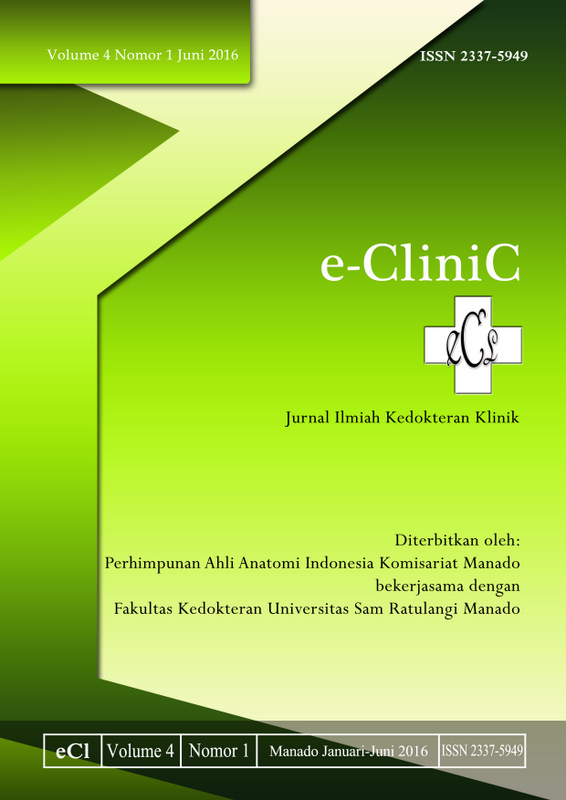Gambaran NIHSS pada Pasien Stroke di Ruang Rawat Inap Neurologi RSUP Prof. Dr. R. D. Kandou Manado periode Juli 2014 - Juni 2015
DOI:
https://doi.org/10.35790/ecl.v4i1.12480Abstract
Abstract: Stroke is the interruption of blood flow to the brain that occurs suddenly and persists for more than 24 hours, which can cause disability. NIHSS is a measurement tool assessing the outcomes of stroke. This study aimed to describe NIHSS in stroke patients in the Neurology Departement of Prof. Dr. R. D. Kandou Manado, for the period of July 2014 – June 2015. This is a descriptive retrospective study which used secondary data in the form of inpatients medical record. The result of this study showed that 136 stroke patients who met the criteria used the NIHSS examination with a total of 73 male patients (53,7%) and 63 female patients (46,3%). The largest age group was 41 – 65 years with a total of 96 patients (70,58%) and based on the educational level, most patients had high school degree or equivalent as the latest educational level with a total of 66 patients (48,52%). NIHSS examination in admitted hemorrhagic stroke patients were 28 patients (60%) consisting of 3 patients in the minor category, 16 patients in the moderate category, and 9 patients in the severe category, whereas the discharged patients were 19 patients (40%), consisting of 6 patients in the normal category, 5 patients in the minor category, 6 patients in the moderate category, and 2 patients in the severe category. NIHSS examination in admitted non-hemorrhagic stroke patients were 45 patients (51%), consisting of 3 patients in the minor category, 32 patients in the moderate category, and 10 patients in the severe category, whereas discharged patients were 44 patients (49%) consisting of 6 patients in the normal category, 10 patients in the minor category, 26 patients in the moderate category, and 2 patients in the severe category.
Keywords: Stroke Patients, NIHSS Examination
Â
Abstrak: Stroke adalah gangguan aliran darah ke otak yang terjadi mendadak dan bertahan dalam waktu lebih dari 24 jam, yang dapat menimbulkan kecacatan. Pemeriksaan NIHSS merupakan alat ukur yang di gunakan menilai luaran stroke. Penelitian ini bertujuan untuk mengetahui gambaran NIHSS pada pasien stroke di ruang rawat inap Neurologi Prof. Dr. R. D. Kandou Manado, periode Juli 2014 - Juni 2015. Penelitian ini bersifat deskriptif retrospektif dengan memanfaatkan data sekunder berupa catatan rekam medik pasien rawat inap. Hasil penelitian ini didapatkan 136 pasien stroke yang memenuhi kriteria menggunakan pemeriksaan NIHSS dengan jumlah pasien laki-laki sebanyak 73 pasien (53,7%) dan perempuan 63 pasien(46,3%). Kelompok umur terbanyak adalah 41-65 tahun dengan jumlah 96 pasien (70,58%) dan kategori pendidikan terakhir paling banyak SMA atau sederajat didapatkan sebanyak 66 pasien (48,52%). Pemeriksaan NIHSS pada stroke hemoragik yang masuk sebanyak 28 pasien (60%) dengan kategori ringan 3 pasien, sedang 16 pasien, dan berat 9 pasien sedangkan pasien keluar sebanyak 19 pasien (40%) dengan kategori normal 6 pasien, ringan 5 pasien, sedang 6 pasien, dan berat 2 pasien. Pemeriksaan NIHSS pada stroke non hemoragik yang masuk sebanyak 45 pasien (51%) dengan kategori ringan 3 pasien, sedang 32 pasien, dan berat 10 pasien sedangkan pasien keluar sebanyak 44 pasien (49%) dengankategori normal 6 pasien, ringan 10 pasien, sedang 26 pasien, dan berat 2 pasien.
Kata kunci : Pasien Stroke, Pemeriksaan NIHSS
Downloads
Published
How to Cite
Issue
Section
License
COPYRIGHT
Authors who publish with this journal agree to the following terms:
Authors hold their copyright and grant this journal the privilege of first publication, with the work simultaneously licensed under a Creative Commons Attribution License that permits others to impart the work with an acknowledgment of the work's origin and initial publication by this journal.
Authors can enter into separate or additional contractual arrangements for the non-exclusive distribution of the journal's published version of the work (for example, post it to an institutional repository or publish it in a book), with an acknowledgment of its underlying publication in this journal.
Authors are permitted and encouraged to post their work online (for example, in institutional repositories or on their website) as it can lead to productive exchanges, as well as earlier and greater citation of the published work (See The Effect of Open Access).







